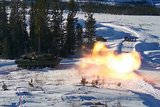What will next-generation mortars look like?
Tomorrow’s mortar systems are expected to be more deployable and survivable. (Photo: US Army)
The war in Ukraine has been showing the relevance of ground capabilities as it drives the defence industry and armies worldwide towards investing in upgrading current mortars.
To provide better organic indirect fire support to manoeuvre land units, the next-generation of mortar systems are expected to offer improved mobility and range, as well as advanced guided capacities that use GPS and laser.
Future mortars will also be more deployable and survivable in addition to being able to better avoid adversarial close combat counterfire. The deployment of advanced ammunition will play a relevant role in such a scenario as tomorrow’s rounds will be
Already have an account? Log in
Want to keep reading this article?
More from Land Warfare
-
Germany signs multi-billion-dollar deals for 6x6 CAVS and GDELS Eagle vehicles
The order is a further boost for the Common Armoured Vehicles System programme which has notched notable successes in the past 12 months. The first vehicle, made in Finland, will be delivered next year with local production expected to ramp up in 2027.
-
![Rheinmetall and KNDS tank tie-up narrows trans-European options]()
Rheinmetall and KNDS tank tie-up narrows trans-European options
The French and German governments signed an agreement in June 2018 to cooperate on the development of a new main battle tank under the Main Ground Combat System programme but the effort has struggled. This new agreement may damage it further.
-
![Hungary set to begin using Hero 400 loitering munitions]()
Hungary set to begin using Hero 400 loitering munitions
Developed by Israel's Uvision and with systems being sold in the thousands to multiple European NATO countries and the US, the Hero family of loitering systems is also in production in the US and Italy, the latter through Rheinmetall.
-
![Light Reconnaissance Strike – enabling a vital mission set (Studio)]()
Light Reconnaissance Strike – enabling a vital mission set (Studio)
A new system-of-systems concept will unlock digital integration of sensors and weapons for Light Forces, allowing them to shape the battlefield environment on their own terms and upgrade legacy platforms.

























